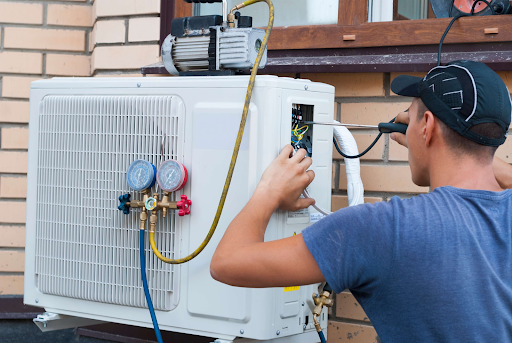As temperatures continue to rise, having a reliable air conditioning system is more than a luxury—it’s a necessity. For homeowners considering air conditioning installation, understanding the process and making informed decisions can save both time and money. This guide will walk you through everything you need to know about air conditioning installation and touch on the importance of AC repair and maintenance for long-term efficiency.
1. Understanding Air Conditioning Systems
Before installing a new air conditioning system, it’s essential to understand the different types of systems available. The most common types include:
- Central Air Conditioning: This system circulates cool air through a network of ducts. It’s ideal for larger homes and offers even cooling throughout the space.
- Ductless Mini-Split Systems: These systems are perfect for homes without existing ductwork or for cooling specific zones. They are efficient and can be installed quickly.
- Window or Portable Units: While more affordable upfront, these systems are not as energy-efficient for long-term use and are typically suited for smaller spaces or temporary cooling needs.
Choosing the right system depends on your home’s size, existing infrastructure, and budget.
2. Assessing Your Home’s Cooling Needs
A key step in air conditioning installation is determining your home’s cooling requirements. A professional HVAC contractor will perform a load calculation, considering factors such as:
- Square footage of your home
- Insulation levels
- Window size and placement
- Sun exposure
This assessment ensures that the air conditioning unit selected is appropriately sized for your home, preventing issues like inadequate cooling or excessive energy consumption.
3. The Installation Process: What to Expect
The air conditioning installation process typically involves several steps, each requiring professional attention to ensure optimal system performance and safety.
Pre-Installation Preparation
- Inspection and Planning: An HVAC professional will assess your home’s layout, existing ductwork (if applicable), and electrical systems to ensure they can support the new AC unit. Necessary upgrades, such as improving insulation or reinforcing electrical capacity, may be recommended.
- Permits: Depending on local regulations, permits may be required for air conditioning installation. A reputable contractor will handle this process to ensure compliance with all building codes.
System Installation
- Mounting and Securing: The outdoor unit is installed in an appropriate location, typically on a concrete pad to reduce vibration and noise. The indoor unit, for central systems, will be installed in a utility area, while ductless mini-split systems are mounted in specific rooms.
- Connecting the System: Copper refrigerant lines, electrical wiring, and drainage lines are connected between the indoor and outdoor units.
- Testing and Calibration: Once installed, the HVAC technician will test the system to ensure proper refrigerant levels, electrical connections, and airflow. They will also calibrate the thermostat and verify the system’s performance.
Post-Installation Inspection
After installation, the HVAC contractor will perform a final walkthrough to explain the system’s operation, thermostat settings, and maintenance tips to the homeowner.
4. The Importance of AC Repair and Maintenance
While a new air conditioning system offers comfort and energy efficiency, ongoing maintenance is critical to prolong its lifespan and prevent costly breakdowns. Neglecting routine care can lead to decreased performance and increased energy bills.
Regular Maintenance Tips
- Change Air Filters: Air filters should be replaced every 1-3 months to ensure proper airflow and reduce the strain on the system.
- Check Refrigerant Levels: Low refrigerant levels can indicate a leak, leading to poor cooling performance. Regular inspections will help catch and fix any issues early.
- Clean Coils: Over time, the condenser and evaporator coils can collect dust and debris, reducing efficiency. Cleaning these coils annually improves system performance.
When to Consider AC Repair
Even with regular maintenance, air conditioners can develop problems over time. Signs that it’s time for ac repair include:
- Inconsistent Cooling: If some rooms are cooler than others, there may be an issue with the ductwork or the cooling system’s distribution.
- Unusual Noises: Banging, clanking, or hissing sounds from the AC unit can indicate a mechanical problem or refrigerant leak.
- High Energy Bills: A sudden spike in energy consumption without a corresponding increase in usage could signal an inefficient system that needs repair.
Timely AC repairs can prevent minor issues from turning into major, expensive problems and ensure your system continues to operate efficiently.
5. The Role of Professional Installation
Hiring a qualified HVAC contractor for air conditioning installation is essential for system longevity, performance, and safety. Professional installation offers several advantages:
- Warranty Protection: Many manufacturers require professional installation to honor their warranties. Attempting a DIY installation or hiring unlicensed technicians could void your warranty.
- Proper Sizing and Calibration: An experienced contractor ensures the system is correctly sized for your home and calibrated for optimal performance.
- Safety Compliance: HVAC professionals are trained to handle refrigerants and electrical systems safely, reducing the risk of accidents during installation.
6. Energy Efficiency and Cost Savings
One of the most significant benefits of installing a new air conditioning system is the potential for energy savings. Modern systems are designed to be highly efficient, reducing overall energy consumption. Homeowners can maximize savings by choosing an energy-efficient model with a high SEER (Seasonal Energy Efficiency Ratio) rating.
In addition to the energy savings, investing in a modern AC system reduces the frequency and cost of AC repair, as newer systems often come with improved components and warranties.
Conclusion
Air conditioning installation is a significant investment for homeowners, and understanding the process can make the experience smoother and more cost-effective. From choosing the right system to ensuring professional installation and maintaining your system with regular care and AC repair, taking these steps will ensure your home remains comfortable and efficient for years to come.
By following this guide, homeowners can feel confident in their air conditioning installation decisions and enjoy the benefits of a well-functioning system throughout the hottest months of the year.


